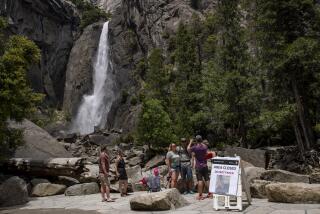Yosemite’s largest ice mass is melting fast
- Share via
Climate change is taking a visible toll on Yosemite National Park, where the largest ice mass in the park is in a death spiral, geologists say.
During an annual trek to the glacier deep in Yosemite’s backcountry last month, Greg Stock, the park’s first full-time geologist, found that Lyell Glacier had shrunk visibly since his visit last year, continuing a trend that began more than a century ago.
Lyell has dropped 62% of its mass and lost 120 vertical feet of ice over the last 100 years. “We give it 20 years or so of existence — then it’ll vanish, leaving behind rocky debris,” Stock said.
The Sierra Nevada Mountains have roughly 100 remaining glaciers, two of them in Yosemite. The shrinkage of glaciers across the Sierra is also occurring around the world. Great ice sheets are dwindling, prompting concerns about what happens next to surrounding ecological systems after perennial rivulets of melted ice disappear.
“We’ve looked at glaciers in California, Colorado, Wyoming, Washington and elsewhere, and they’re all thinning because of warming temperatures and less precipitation,” said Andrew Fountain, professor of geology and geography at Portland State University in Oregon. “This is the beginning of the end of these things.”
If carbon dioxide levels continue to rise, the earth will eventually become ice-free, according to a study by Ken MacLeod, a professor of geological sciences at the University of Missouri, published in the October issue of the journal Geology.
Research by scientists at NASA, the U.S. Geological Survey and UC Davis suggests that absorption of sunlight in snow by industrial air pollution including soot, or black carbon, is also causing snow and ice to melt faster.
Yosemite’s other glacier, Maclure, is also shrinking, but it remains alive and continues to creep at a rate of about an inch a day.
Lyell, however, hasn’t budged. It is the second largest glacier in the Sierra Nevada and the headwater of the Tuolumne River watershed, but it no longer fits the definition of a glacier because it has ceased moving.
“Lyell Glacier is stagnant — a clear sign it’s dying,” Stock said. “Our research indicates it stopped moving about a decade ago.”
Of particular concern is the effect on Yosemite’s Tuolumne Meadows. After two years of drought, many of the streams that nourish the picturesque meadowlands have gone dry. The one exception, however, is the Lyell Fork of the Tuolumne River, which is sustained by runoff from Lyell and Maclure glaciers.
“When the glaciers are gone, there will be no steady supplies of water in that drainage,” Stock said. “We don’t know what the impacts of that will be on plants and animals that evolved with these ice flows.”
Future research projects will attempt to use climate shifts chronicled in the widths of tree rings in nearby forests to create computer models that will show the shrinkage of Yosemite’s glaciers over the last 300 years — and help predict when they will disappear entirely.
Scientists also want to know why Lyell has stopped moving when neighboring Maclure, which is half the size it was a century ago, continues to advance at the same rate it did when naturalist John Muir and his friend Galen Clark hammered wooden stakes into its icy crust in 1872 to prove that glaciers are “living” because they move and alter the landscape as they do so.
“Glaciers tend to flow like honey down a plate, or slide over meltwater beneath them,” Stock said. “We suspect Lyell just isn’t thick enough anymore to drive a downhill motion.”
Overall, “the rate of glacier retreat has accelerated since about 2000,” Stock said. “Eventually, there’ll be nothing left.”
That’s already happened at least once in Yosemite, geologists say. Black Mountain Glacier, which Muir discovered, surveyed and declared “living” in 1871, was gone by the mid-1980s.
More to Read
Sign up for Essential California
The most important California stories and recommendations in your inbox every morning.
You may occasionally receive promotional content from the Los Angeles Times.











